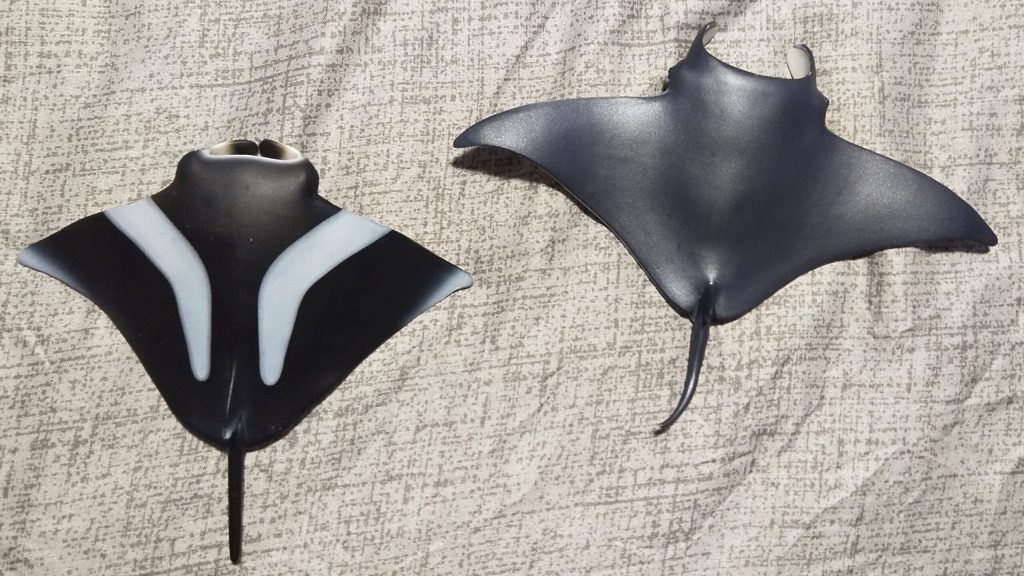Review and images by JimoAi; edited by bmathison1972
In the warm waters around the Galapagos Islands, a giant oceanic manta ray (Mobula birostris) swoops by, causing the nearby fish to flee due to the large size of the ray. She opens her large mouth to allow zooplankton to be collected and in turn, her gill rakers filter them, allowing seawater to be exhaled. However, nature is seldom free of risks. A nearby male orca is hungry and has found a potential meal. The manta ray spots the cetacean, and despite her large size, she leaps completely out of the water to avoid the predator. However, the escape attempt was foiled as the orca managed to get a bite out of the right pectoral fin and took a large chunk out of it. Fortunately for her, the manta ray managed to escape and her wound will soon heal due to the rapid healing properties she has. Unfortunately, giant manta rays have since been listed as Endangered by the ‘IUCN’ due to their slow reproductive rates and growth in demand for their gill rakers for the Chinese medicine trade.


About the figure: the figure is about 18 cm wide, 19 cm when the fins are in a straight position. Judging by the mouth being a dark colour, proportion of the head to the finspan, and the gill proportion, I am going to assume and use this figure as Mobula birostris. This figure was released in 2009, they year which suggests there were in fact 2 species of manta rays instead of 1, but the figure was sculpted way earlier and thus, can be justified as being worked on before the recognition of 2 different manta ray speciess. Female giant mantas (which this figure clearly represents) get to about 500 cm before they can reproduce and up to 700 cm, though the largest one on record was 910 cm, though such giant phantoms are rare nowadays. This puts the figure at the 1:28 to 1:47 scale, depending on the measurement you are going with.


The coloration of this manta is this metallic blackish gray with a white underbelly, devoid of any patterning. Manta rays are known to have unique patterning, just like our finger prints, and this figure is devoid of any spots on the bottom, which is a shame as this ray looks to be decided of an individual personality and it’s a missed opportunity for Papo to go for a unique patterned ray, or maybe a black individual or the elusive pink manta ray.

The figure is sculpted with the ray flapping her wings gently with her mouth open, to collect zooplankton and other small animals into the cavernous mouth, which the gill rakers are sculpted and painted. The cephalic fins are curved inwards, which is the norm for most manta ray figures. It would be nice to see the cephalic fins be folded like bullets as these animals would normally do. The dorsal fin seems a little too tiny and the figure seems to be lacking the vestegial spine that is present on Mobula birostris, one of the key features that seperate it from the reef manta ray, Mobula alfredi (but to Papo’s credit, this figure was sculpted way before the latter was recognized as a valid species).

Here’s it next to Schleich’s reef manta ray for comparison in the difference in physical features and size:

Overall, I think that this is a decent manta ray figure that I am sure will impress any fans of Batoidea or marine life in general. Although it has minor inaccuracies like the lack of patterning, small dorsal fin, and the lack of the vestigial spine, I think this figure is still among the better manta rays made by a major toy company. This figure is still in production and should be available in places that sell Papo figures at a relatively inexpensive price. Other options for manta rays will be Safari’s MBA and standard giant mantas, or if you are interested in its smaller relative, CollectA and the retired 2013 Schleich are good options.

Compared to a 1:30 scale Matsuura Kanan figure, which puts this Manta ray at the 570 cm range:

Disclaimer: links to Ebay and Amazon on the AnimalToyBlog are affiliate links, so we make a small commission if you use them. Thanks for supporting us!




I like how the mouth is open on this one.